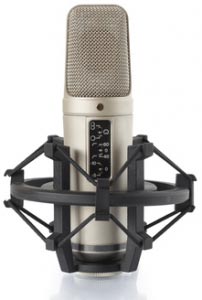What Do Those Switches On My Microphone Mean?
A reader recently asked about the switches he had on his microphone. He referred to one switch that selected between a straight horizontal line (he said he’d read it was called a “high-pass filter”) and a bent/broken white line, and another that provides an alternative between a 0db or -10db setting. I must admit that I remember having the same question when I first saw these switches on a mic.
Here is my reply to him:
As for the switches on the mics, one of them is called a “roll-off” switch. That’s the one that looks like a broken line. You’re right that it is a high-pass filter (lets the higher frequencies “pass,” but turns the volume down on the low frequencies). It reduces the low-end frequencies that get picked up by the mic. I use this if I’m getting too many p-pops in my vocals, or if there is too much bass in whatever I’m recording.

But as a default, I’d leave it flat. The threshold frequency (the point where the line bends) is usually written on the mic, but not on the Oktava, if it’s like mine (see the picture below), which is the Oktava MK-319. You would have to look that up in the mic’s documentation. I just looked up the specs on line (www.oktava-online.com/mk319.htm) and it did not say.

Usually it’s set to either 80 Hz (“hertz,” or “cycles-per-second”) or 40 Hz. My Rode NT2-A (picture at top) has both of those. So what this does is pick up all frequencies as normal, except the ones starting where the line bends (was to the left end of the frequency spectrum, which is the low or bass end), typically at 40 or 80 Hz.
From that point, all the frequencies to the left (the frequencies lower than that) are turned down. According to the Oktava site, this high-pass filter reduces bass frequencies “directly at the input of the microphone amplifier.”
The 0dB or -10dB switch reduces the output of the mic when engaged. See the pic on the right of my Oktava and note the Cyrillic characters for “d” and “b.” This is because the mic is Russian.
Anyway, so leaving it at 0dB is the default and causes no reduction in output. Engaging the -10 dB switch will reduce the output of the mic (basically turn it down) by 10 decibels. I never use this unless, for some reason, the mic’s output is too much for whatever it’s plugged into (some sort of audio interface or a mixer). But if you do need to reduce the level of the mic’s output, you can use that switch.
I hope that helps!
Cheers,
Ken


Thank You!
You’re welcome, Jess!
Ken
I have a cardioid condenser ec7 super scope microphone with three settings off m &v what is the difference in that
That mic is really not good for recording with modern devices. It was made for portable tape recorders from the 70s and 80s. I assume the switch you refer to had something to do with that. But I don’t know. I highly recommend getting a brtter mic, which these days you can get for $79 – the Audio-Technica ATR2100x.
Thank you for this!!
On my MXL 4000 there is one more switch that I have no idea what it does. There are 3 options. One looks like an ‘8’, the middle one an ‘O’ and the last on looks likes similar to the ‘O” but with a dent in the bottom. Kind’ve like pacman facing down… if that makes any sense.
Do you have any idea what those do?
Thanks!!
that sounds like the Cardioid setting. It should look more like a heart. Does it look like this?: https://screencast.com/t/23cHf4eE8fF3 If so, check out this post and video – https://www.homebrewaudio.com/improve-quality-audio-record-home-tip-2/
Hope that helps.
Ken
Yes, thank you Ken! This explained things perfectly!! And yes, it looks much more like a heart than pacman ha! Thank you so much for the information!
You’re welcome Drew:).
Ken
Thanks mate…sorted me out.
Excellent! Glad it helped:).
Hi, I’m doing a level music tech and this really helped me out but are there specific names for the switchs?
Usually “pad switch” and “pattern switch.”